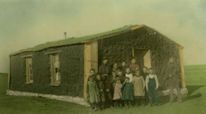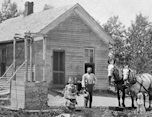This week marks the 151
st anniversary of the passage of the
Homestead Act on May 20, 1862. Homesteaders were allotted 160 acres of land. They had to live on their land and make improvements within six months, including building a home. After 5 years on the land, the original filer was entitled to the property after paying a small registration fee. On January 1, 1863, Daniel Freeman met some local Land Office officials and convinced a clerk to open the office shortly after midnight in order to file a land claim. Freeman became one of the first to
file a claim. 160 acres proved to be too small for the arid parts of Nebraska. The
Kinkaid Act of 1904, authored by Nebraska Congressman Moses P. Kinkaid, increased the allotment to 640 acres in western and central portions of Nebraska, primarily in the Sandhills.
Trees were in short supply , and the tough sod
being “busted” for crop production became
 building blocks
building blocks for homes, barns, and even schools.
Several Nebraska Memories participants have
contributed photos depicting homesteaders.
The house in this photo of the
Mundshaw’s Sod House from the Cheyenne County Historical Society collection looks quite substantial, with a durable roof and glass windows. It probably had a wood floor as well.

Cheyenne county also boasted a
Sod School in District #68 . It actually had a stone foundation. Eight of the children in this 1904-05 picture are named Olsen, with photographer Otto Olsen using a string to snap the photo so that he could be in it.
Other parts of Nebraska had trees for lumber.
 Mr. and Mrs. James Cornell and their children
Mr. and Mrs. James Cornell and their children
stand in front of a wood frame house in Butler County
in this photograph from the Boston Studio Project
collection, taken in the late 1890s.

There was no Kingsley Dam or Tri-County irrigation canal holding and diverting water from the Platte River into parched fields in Phelps County in those early days. It’s hard to imagine how the family in the 1880’s photo of their
Dry land farm, Phelps County, Nebraska survived. The rows of corn look dried up. Perhaps the windmill behind the house provided enough water for the crop.
Visit
Nebraska Memories to search for or browse through many more historical images digitized from photographs, negatives, postcards, maps, lantern slides, books and other materials.
Nebraska Memories is a cooperative project to digitize Nebraska-related historical and cultural heritage materials and make them available to researchers of all ages via the Internet. Nebraska Memories is brought to you by the Nebraska Library Commission. If your institution is interested in participating in Nebraska Memories, see
http://nlc.nebraska.gov/nebraskamemories/participation.aspx for more information, or contact
Beth Goble, Historical Services Librarian, or
Devra Dragos, Technology & Access Services Director.
 building blocks for homes, barns, and even schools.
Several Nebraska Memories participants have
contributed photos depicting homesteaders.
The house in this photo of the Mundshaw’s Sod House from the Cheyenne County Historical Society collection looks quite substantial, with a durable roof and glass windows. It probably had a wood floor as well.
building blocks for homes, barns, and even schools.
Several Nebraska Memories participants have
contributed photos depicting homesteaders.
The house in this photo of the Mundshaw’s Sod House from the Cheyenne County Historical Society collection looks quite substantial, with a durable roof and glass windows. It probably had a wood floor as well.  Cheyenne county also boasted a Sod School in District #68 . It actually had a stone foundation. Eight of the children in this 1904-05 picture are named Olsen, with photographer Otto Olsen using a string to snap the photo so that he could be in it.
Other parts of Nebraska had trees for lumber.
Cheyenne county also boasted a Sod School in District #68 . It actually had a stone foundation. Eight of the children in this 1904-05 picture are named Olsen, with photographer Otto Olsen using a string to snap the photo so that he could be in it.
Other parts of Nebraska had trees for lumber.  Mr. and Mrs. James Cornell and their children
stand in front of a wood frame house in Butler County
in this photograph from the Boston Studio Project
collection, taken in the late 1890s.
Mr. and Mrs. James Cornell and their children
stand in front of a wood frame house in Butler County
in this photograph from the Boston Studio Project
collection, taken in the late 1890s.
 There was no Kingsley Dam or Tri-County irrigation canal holding and diverting water from the Platte River into parched fields in Phelps County in those early days. It’s hard to imagine how the family in the 1880’s photo of their Dry land farm, Phelps County, Nebraska survived. The rows of corn look dried up. Perhaps the windmill behind the house provided enough water for the crop.
Visit Nebraska Memories to search for or browse through many more historical images digitized from photographs, negatives, postcards, maps, lantern slides, books and other materials.
Nebraska Memories is a cooperative project to digitize Nebraska-related historical and cultural heritage materials and make them available to researchers of all ages via the Internet. Nebraska Memories is brought to you by the Nebraska Library Commission. If your institution is interested in participating in Nebraska Memories, see http://nlc.nebraska.gov/nebraskamemories/participation.aspx for more information, or contact Beth Goble, Historical Services Librarian, or Devra Dragos, Technology & Access Services Director.
There was no Kingsley Dam or Tri-County irrigation canal holding and diverting water from the Platte River into parched fields in Phelps County in those early days. It’s hard to imagine how the family in the 1880’s photo of their Dry land farm, Phelps County, Nebraska survived. The rows of corn look dried up. Perhaps the windmill behind the house provided enough water for the crop.
Visit Nebraska Memories to search for or browse through many more historical images digitized from photographs, negatives, postcards, maps, lantern slides, books and other materials.
Nebraska Memories is a cooperative project to digitize Nebraska-related historical and cultural heritage materials and make them available to researchers of all ages via the Internet. Nebraska Memories is brought to you by the Nebraska Library Commission. If your institution is interested in participating in Nebraska Memories, see http://nlc.nebraska.gov/nebraskamemories/participation.aspx for more information, or contact Beth Goble, Historical Services Librarian, or Devra Dragos, Technology & Access Services Director. 
